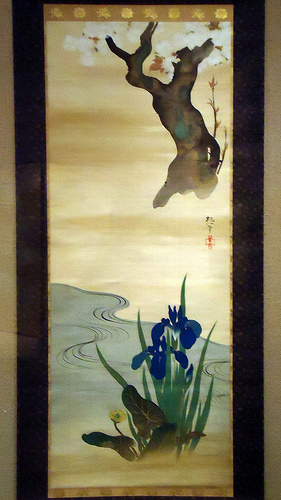Sakai Hoitsu
- Born: 1761/7/1, Edo
- Died: 1828/11/29
- Other Names: 酒井忠因 (Sakai Tadanao); 鶯村 (art-name: Uguisumura); 庭柏子 (art-name: Tei Hakushi); 暉真 (monastic name: Kishin); 杜綾 (haiku name: Toryou); 尻焼猿人 (kyôka poet name: Shiriyake-no-sarundo)
- Japanese: 酒井抱一 (Sakai Houitsu)
Sakai Hôitsu was an Edo-based painter often considered one of the last masters of the Rinpa style.
He was born Sakai Tadanao, the second son of the Sakai clan of Himeji han, and later took on the art-name (gô) Hôitsu, along with numerous other pseudonyms, including poetry names and a monastic name. He began his artistic career pursuing a variety of talents & interests, including studying Kanô school painting, producing ukiyo-e bijinga in the style of Utagawa Toyoharu), and dabbling in both yamato-e and Western modes of painting, including the styles of the Maruyama-Shijô school and Itô Jakuchû. After taking the tonsure in 1797, however, Hôitsu switched to producing works more purely in the Rinpa mode. His family had been patrons of Ogata Kôrin (1658-1716) during Kôrin's life, and owned a number of his works, many of which served as models or inspiration for Hôitsu. Having been born in Edo, however, he tried to create an Edo brand of Rinpa (in contrast to the Kyoto Rinpa of Ogata Kôrin and his predecessors, Hon'ami Kôetsu and Tawaraya Sôtatsu), including Edo themes such as Mt. Fuji and morning glories (asagao) in his paintings.
Towards the end of 1809, opened his own artist's studio in Negishi, called Ugean (雨華庵). In 1815, Hôitsu organized an exhibition of Kôrin's works, on the occasion of the 100th anniversary of Kôrin's death, and also had published a book entitled Kôrin hyakuzu ("One Hundred Pictures by Kôrin"). Hôitsu was closely connected with intellectual and cultural circles in Edo, and an 1820 painting believed to have been created for his 60th birthday, or at a New Year's celebration, includes contributions from a total of sixty-nine artists, poets, and other prominent figures, including Watanabe Kazan, Tani Bunchô, and Hôitsu himself.[1] The majority of his most famous works are believed to have been produced around this time, and in the following years, when Hôitsu was in his sixties. At least one of his works, a pair of folding screens depicting waves against a silver-foil background, based on a painting by Kôrin, is today a National Treasure. Hôitsu also produced throughout his life, in addition to Rinpa paintings, haiku and haiga (simple playful paintings in the spirit of haiku).
Among his students, Suzuki Kiitsu is perhaps the most famous today.
References
- "Sakai Hôitsu." Asahi Nihon rekishi jinbutsu jiten 朝日日本歴史人物事典. Asahi Shinbun-sha.
- "Silver Wind: The Arts of Sakai Hôitsu, 1761-1828." Exhibition gallery labels & guided tour. Japan Society. 13 October 2012.
- ↑ "Miscellaneous Paintings and Calligraphy for the Third Year of the Bunsei Era." Metropolitan Museum of Art.
